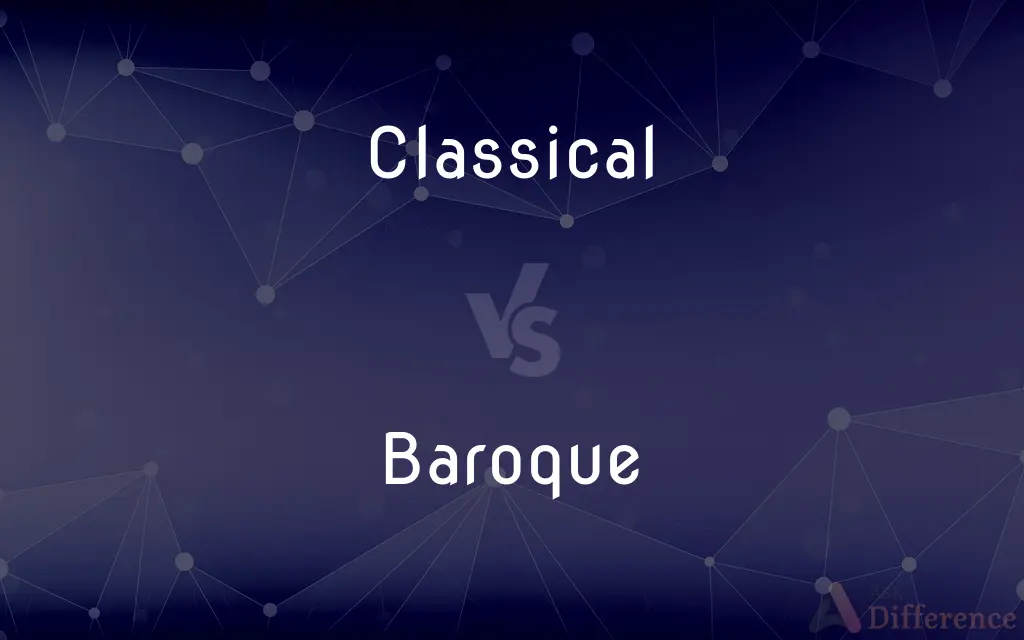Classical vs. Baroque — What's the Difference?
Edited by Tayyaba Rehman — By Fiza Rafique — Updated on October 10, 2023
Classical refers to an 18th-century musical period emphasizing clarity and form; Baroque describes a 17th to mid-18th-century period marked by expressive, ornate styles.

Difference Between Classical and Baroque
Table of Contents
ADVERTISEMENT
Key Differences
Classical and Baroque are both significant periods in the history of Western music, each bringing unique styles and innovations to the world of composition and performance. The Classical period, spanning from the mid-18th century to the early 19th century, is characterized by its clear tonal structures, simplicity, and emphasis on balance and form. On the contrary, Baroque, which preceded the Classical era from around 1600 to 1750, is recognized for its intricate, expressive, and often ornamented compositions.
Originating in Italy, the Baroque period witnessed the emergence of forms like the opera, concerto, and sonata. Baroque compositions often evoke strong emotional responses, characterized by contrast, expressive melodies, and dramatic themes. In this era, music was used to communicate emotions powerfully, with composers like Johann Sebastian Bach, George Frideric Handel, and Antonio Vivaldi leading the way. On the other hand, the Classical era, with luminaries like Wolfgang Amadeus Mozart, Ludwig van Beethoven, and Franz Joseph Haydn, saw the development and refinement of forms like the symphony and the string quartet.
From a stylistic perspective, Classical music tends to prioritize homophonic textures (a primary melody supported by chords), whereas Baroque music leans towards polyphonic textures (multiple, independent melodies occurring simultaneously). This distinction becomes evident when comparing a Baroque fugue with a Classical sonata, where the latter often embodies a clear thematic development and structural clarity.
Instrumentation also witnessed a transformation from the Baroque to the Classical era. While the harpsichord and clavichord were predominant in the Baroque period, the Classical period saw the rise of the fortepiano, which eventually evolved into the modern-day piano. The roles of instruments in orchestral settings also underwent changes, with the Classical orchestra offering more standardized groupings than the varied ensemble arrangements of the Baroque.
In summation, while both Classical and Baroque periods have left indelible marks on the world of music, they differ vastly in style, instrumentation, and compositional approach. The ornate and expressive nature of Baroque stands in contrast to the balanced, clear, and structured essence of Classical music.
ADVERTISEMENT
Comparison Chart
Time Period
Mid-18th century to early 19th century
Approx. 1600 to 1750
Key Composers
Mozart, Beethoven, Haydn
Bach, Handel, Vivaldi
Stylistic Emphasis
Clarity, balance, form
Expressiveness, contrast, ornamentation
Texture
Primarily homophonic
Often polyphonic
Predominant Instruments
Fortepiano, Classical orchestra
Harpsichord, varied ensemble groupings
Compare with Definitions
Classical
Classical refers to the period of music from the mid-18th to early 19th century.
Mozart is a renowned composer from the Classical era.
Baroque
Baroque refers to the style of music, art, and architecture from the 17th to mid-18th century.
Bach's compositions epitomize the Baroque musical style.
Classical
Classical denotes something regarded as a standard or model of excellence.
Shakespeare's works are considered Classical in English literature.
Baroque
Baroque can pertain to the dramatic, ornate style of expression in any art form.
The painting had a Baroque flair, showcasing dynamic contrasts.
Classical
Classical can pertain to ancient Greek or Roman culture.
Classical architecture is inspired by ancient Greek and Roman designs.
Baroque
Baroque can indicate an exaggerated or elaborate style.
The novelist's Baroque writing was filled with intricate metaphors.
Classical
Classical implies traditional or long-established forms or styles.
Classical ballet adheres to traditional techniques and movements.
Baroque
Baroque signifies a pearl of irregular shape.
She wore a necklace adorned with Baroque pearls.
Classical
Of or relating to the ancient Greeks and Romans, especially their art, architecture, and literature.
Baroque
The Baroque (UK: , US: ; French: [baʁɔk]) is a style of architecture, music, dance, painting, sculpture, and other arts that flourished in Europe from the early 17th century until the 1740s. In the territories of the Spanish and Portuguese empires including the Iberian Peninsula it continued, together with new styles, until the first decade of the 1800s.
Classical
Conforming to the artistic and literary models of ancient Greece and Rome.
Baroque
AlsoBaroqueOf, relating to, or characteristic of a style in art and architecture developed in Europe from the early 17th to mid-18th century, emphasizing dramatic, often strained effect and typified by bold, curving forms, elaborate ornamentation, and overall balance of disparate parts.
Classical
Versed in the classics
A classical scholar.
Baroque
AlsoBaroque(Music)Of, relating to, or characteristic of a style of composition that flourished in Europe from about 1600 to 1750, marked by expressive dissonance and elaborate ornamentation.
Classical
Of or relating to European music during the latter half of the 18th and the early 19th centuries.
Baroque
Extravagant, complex, or bizarre, especially in ornamentation:"the baroque, encoded language of post-structural legal and literary theory"(Wendy Kaminer).
Classical
Of or relating to music in the educated European tradition, such as symphony and opera, as opposed to popular or folk music.
Baroque
Irregular in shape:baroque pearls.
Classical
Of, relating to, or being a variety of a language that is epitomized by a prestigious body of literature.
Baroque
The baroque style or period in art, architecture, or music.
Classical
Standard and traditional
Classical methods of navigation.
Baroque
Ornate, intricate, decorated, laden with detail.
Classical
Relating to or being a school of thought or field of study that is established and widely accepted before others
Classical economics.
Baroque
Complex and beautiful, despite an outward irregularity.
Classical
Of or relating to physics that can be described without the use of quantum mechanics or relativity.
Baroque
Chiseled from stone, or shaped from wood, in a garish, crooked, twisted, or slanted sort of way, grotesque.
Classical
Relating to or consisting of studies in the humanities and general sciences
A classical curriculum.
Baroque
Embellished with figures and forms such that every level of relief gives way to more details and contrasts.
Classical
Of or relating to the first class or rank, especially in literature or art.
Baroque
Characteristic of Western art music of about the same period.
Classical
Of or pertaining to established principles in a discipline.
Baroque
(figuratively) Overly and needlessly complicated.
Grotesquely baroque bureaucratic hassles
Baroque bookkeeping in pursuit of tax dodges
Classical
(music) Describing Western music and musicians of the late 18th and early 19th centuries.
Baroque
An ornate, detailed style.
Classical
Describing art music (rather than pop, jazz, blues, etc), especially when played using instruments of the orchestra.
Baroque
Of, pertaining to, or characteristic of, an artistic style common in the 17th century, characterized by the use of complex and elaborate ornamentation, curved rather than straight lines, and, in music a high degree of embellishment.
Classical
Of or pertaining to the ancient Greeks and Romans, especially to Greek or Roman authors of the highest rank, or of the period when their best literature was produced; of or pertaining to places inhabited by the ancient Greeks and Romans, or rendered famous by their deeds.
Baroque
Hence, overly complicated, or ornamented to excess; in bad taste; grotesque; odd.
Classical
Knowledgeable or skilled in the classics; versed in the classics.
A classical scholar
Baroque
Irregular in form; - said esp. of a pearl.
Classical
Conforming to the best authority in literature and art; chaste; pure; refined
Classical dance.
Baroque
Elaborate an extensive ornamentation in decorative art and architecture that flourished in Europe in the 17th century
Classical
(physics) Pertaining to models of physical laws that do not take quantum or relativistic effects into account; Newtonian or Maxwellian.
Baroque
Having elaborate symmetrical ornamentation;
The building...frantically baroque
Classical
(countable) One that is classical in some way; for example, a classical economist.
Baroque
Baroque describes something ornate or intricately designed.
The palace had Baroque decorations with lavish details.
Classical
(chess) classical chess
Classical
Of or characteristic of a form or system felt to be of first significance before modern times
Classical
Of recognized authority or excellence;
The definitive work on Greece
Classical methods of navigation
Classical
Classical can describe something fundamental or basic.
The experiment was based on Classical physics principles.
Common Curiosities
Which period came first, Classical or Baroque?
The Baroque period preceded the Classical period.
When did the Classical period in music occur?
The Classical period spanned from the mid-18th century to the early 19th century.
What are defining characteristics of Baroque music?
Baroque music is characterized by its expressiveness, ornamentation, contrast, and often polyphonic texture.
What kind of texture is dominant in Classical music?
Classical music primarily features a homophonic texture.
Is the term "Baroque" exclusive to music?
No, "Baroque" also describes a style of art, architecture, and literature from the same period.
Who are some prominent composers from the Classical era?
Prominent Classical composers include Wolfgang Amadeus Mozart, Ludwig van Beethoven, and Franz Joseph Haydn.
How does Baroque architecture differ from Classical architecture?
Baroque architecture is more ornate and elaborate, while Classical architecture is inspired by the simplicity and balance of ancient Greek and Roman designs.
Were any new musical forms introduced during the Classical period?
Yes, the Classical period saw the development and refinement of forms like the symphony and string quartet.
How does the instrumentation in Baroque music compare to Classical music?
Baroque music often utilized the harpsichord and had varied ensemble arrangements, while Classical music favored the fortepiano and had more standardized orchestral groupings.
Which instrument became prominent during the Classical era, replacing the harpsichord?
The fortepiano, which evolved into the modern-day piano, became prominent during the Classical era.
What's a key difference in the themes of Baroque and Classical compositions?
While Baroque music often focused on contrast and expressive melodies, Classical compositions emphasized balance, clarity, and structured thematic development.
In which art forms can the term "Classical" be applied?
"Classical" can be applied to music, literature, architecture, and other forms of art that adhere to traditional or long-established standards.
Can the term "Baroque" describe a type of pearl?
Yes, "Baroque" can refer to pearls that are of irregular shape.
Is Baroque music emotionally expressive?
Yes, Baroque music is known for its strong emotional expressiveness and dramatic themes.
How do Baroque and Classical orchestras differ?
Classical orchestras offer more standardized groupings and roles for instruments, while Baroque ensembles had varied arrangements.
Share Your Discovery

Previous Comparison
Diptych vs. Writing
Next Comparison
State vs. SocietyAuthor Spotlight
Written by
Fiza RafiqueFiza Rafique is a skilled content writer at AskDifference.com, where she meticulously refines and enhances written pieces. Drawing from her vast editorial expertise, Fiza ensures clarity, accuracy, and precision in every article. Passionate about language, she continually seeks to elevate the quality of content for readers worldwide.
Edited by
Tayyaba RehmanTayyaba Rehman is a distinguished writer, currently serving as a primary contributor to askdifference.com. As a researcher in semantics and etymology, Tayyaba's passion for the complexity of languages and their distinctions has found a perfect home on the platform. Tayyaba delves into the intricacies of language, distinguishing between commonly confused words and phrases, thereby providing clarity for readers worldwide.














































